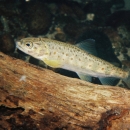States
New YorkThis project will replace an existing dual culvert crossing over the North Branch of the Boquet River with a 120-foot bridge. Current conditions include a perched invert aquatic passage barrier, a sheet pile cut off wall aquatic barrier, and complete fragmentation of bank and flood plain connectivity for aquatic and terrestrial passage. The current combined opening of 32 feet represents a constriction for the estimated 85-foot bankfull width of the river at that location. Removal of this barrier will open 49 upstream miles of river and coldwater tributary habitat for native brook trout, American eel and landlocked Atlantic salmon. This project will also improve water quality and public safety, as well as restore natural stream function to the river.
Project Quick Facts:
| Location | New York |
| NFPP Project Funding | $500,000 |
| Restoration Techniques | Culvert Replacement |
| Partner Project Lead | Essex County, New York Department of Public Works |
The National Fish Passage Program combines technical expertise with a track record of success.
Implemented primarily through the Service's Fish and Wildlife Conservation Offices, the National Fish Passage Program provides financial and technical assistance to partners across the country. Since 1999, the program has worked with over 2,000 local communities, Tribes, and private landowners to remove or bypass over 3,400 barriers to fish passage fish passage
Fish passage is the ability of fish or other aquatic species to move freely throughout their life to find food, reproduce, and complete their natural migration cycles. Millions of barriers to fish passage across the country are fragmenting habitat and leading to species declines. The U.S. Fish and Wildlife Service's National Fish Passage Program is working to reconnect watersheds to benefit both wildlife and people.
Learn more about fish passage and reopen access to over 61,000 miles of upstream habitat for fish and other animals. Staff have expertise in fish migration and biology as well as financial, engineering, and planning assistance to communities, Tribes, and landowners to help them remove barriers and restore rivers for the benefit both fish and people.
Fish passage project proposals can be initiated by any individual, organization, government, or agency. However, proposals must be submitted and completed in cooperation with a Fish and Wildlife Conservation Office. (Please note that fish passage projects being used for federal or state compensatory mitigation or required by existing federal or state regulatory programs are not eligible for funding through the National Fish Passage Program.)
CONTACT A FISH PASSAGE COORDINATOR IN YOUR AREA TO GET STARTED.





